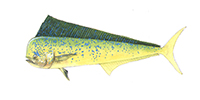Thank you for visiting the Seafood Selector. EDF is planning a new approach to providing information to consumers about good seafood choices. Please come back soon for updates.
Mahimahi

Mahimahi/Bull dolphin, © Amadeo Bachar
Recommended servings per month
| Contaminant | Men | Women | Kids 6-12 | Kids 0-5 | |
|---|---|---|---|---|---|
| Mahimahi (imported, longline) | Mercury | 4+ | 4+ | 4+ | 3 |
| Mahimahi (imported troll/pole) | Mercury | 4+ | 4+ | 4+ | 3 |
| Mahimahi (U.S. longline) | Mercury | 4+ | 4+ | 4+ | 3 |
| Mahimahi (U.S. troll/pole) | Mercury | 4+ | 4+ | 4+ | 3 |
Eco details:
Mahimahi (also known as Mahi) populations are resilient to fishing since they grow quickly, spawn frequently, and have large ranges. These fish are caught with hook and line (low bycatch) and longlines (high bycatch). The U.S. South Atlantic fishery has shown welcome initiative to establish management for this species, which is largely unregulated elsewhere.




